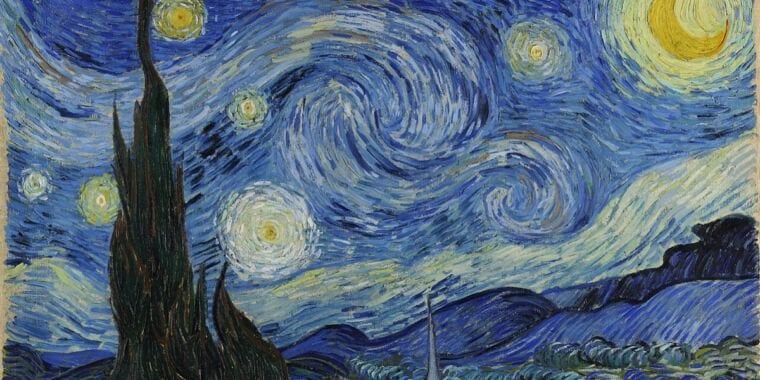
Physicists discover “hidden turbulence” throughout van Gogh’s Starry Night | Scientists measured scaling of the brush strokes to arrive at their conclusions
https://arstechnica.com/science/2024/09/physicists-discover-hidden-turbulence-throughout-van-goghs-starry-night/
3 Comments
Article excerpts:
>According to a new paper published in the journal Physics of Fluids, the illusion of movement in van Gogh’s blue sky is also due to the scale of the paint strokes—a second kind of “hidden turbulence” at the microscale that diffuses throughout the entire canvas.
>
>“It reveals a deep and intuitive understanding of natural phenomena,” said co-author Yongxiang Huang of Xiamen University in China. “Van Gogh’s precise representation of turbulence might be from studying the movement of clouds and the atmosphere or an innate sense of how to capture the dynamism of the sky.”
>
>…
>
>Their findings confirmed the 2019 conclusion that the overall painting closely aligns with Kolmogorov’s law. The team also found that, at the microscale, the paint strokes align with a different phenomenon known as Batchelor’s scaling, named after Australian mathematician George Batchelor, who specialized in fluid dynamics. It’s similar to Kolmogorov’s law, except instead of describing the smallest scales of turbulence before viscosity becomes dominant in a system, Batchelor scaling describes the smallest-length scales of fluctuations before diffusion becomes dominant. Per the authors, it’s quite rare to find both these kinds of scaling in one atmospheric system.
>
>This is yet more evidence that van Gogh had an exquisitely fine-tuned intuitive sense of turbulence, and he captured it beautifully in Starry Night. There may also be implications for fluid dynamics. “Turbulence is believed to be one of the intrinsic properties of high Reynolds flows dominated by inertia, but recently, turbulence-like phenomena have been reported for different types of flow systems at a wide range of spatial scales, with low Reynolds numbers where viscosity is more dominant,” Huang said. “It seems it is time to propose a new definition of turbulence to embrace more situations.”
—
Link to the journal (DOI listed in article appears to be broken as of this comment):
[Hidden turbulence in van Gogh’s The Starry Night](https://pubs.aip.org/aip/pof/article-abstract/36/9/095140/3312767/Hidden-turbulence-in-van-Gogh-s-The-Starry-Night)
Abstract:
>Turbulent skies have often inspired artists, particularly in the iconic swirls of Vincent van Gogh’s The Starry Night. For an extended period, debate has raged over whether the flow pattern in this masterpiece adheres to -5/3 Kolmogorov’s theory of turbulence. In contrast to previous studies that examined only part of this painting, all and only the whirls/eddies in the painting are taken into account in this work, following the Richardson–Kolmogorov’s cascade picture of turbulence. Consequently, the luminance’s Fourier power spectrum spontaneously exhibits a characteristic Kolmogorov-like power-law. This result suggests that van Gogh had a very careful observation of real flows, so that not only the sizes of whirls/eddies in The Starry Night but also their relative distances and intensity follow the physical law that governs turbulent flows. Moreover, a “–1”-like power-law persists in the spectrum below the scales of the smallest whirls, hinting at Batchelor-type scalar turbulence with a high Schmidt number. Our study, thus, unveils the hidden turbulence captured within The Starry Night.
They also could’ve studied The Great Wave and seen (at least one place) where [Van Gogh gained inspiration](https://www.theguardian.com/artanddesign/2018/sep/28/vincent-van-gogh-starry-night-hokusai-great-wave) for some of that turbulence.
There is a mountain peak near where I live which, when under the right conditions (snowy, but, the snow is very powdery which happens here due to a lake effect, and windy but clear skies) produces “dust” clouds that look just like what van gogh has painted.
So my suspicion is that he has simply seen the same phenomenon or something similar, wind blowing over a peak leading to turbulence made visible by snow, dust, fog, or whatever was in that air.
Personally, I found it fascinating enough to attempt to photograph it a number of times but never got a satisfying shot. It was much easier to see with the eyes than capture with the sensor tech available to me then.